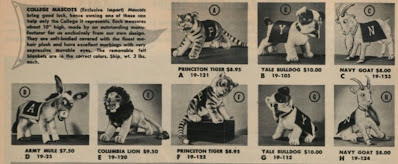"Hello, I have bought an antique Steiff and can't find anything about it in the Pfeiffer catalogue. He is about 38 cm standing, many bald spots but the remaining hair is fair blonde and long mohair. He is excelsior stuffed, some is showing through small holes near the nose etc. He still has his button. His covering is light pink, the mohair looks a very light blonde, but it could be faded. His glass eyes are a bit different than the others I have from that same period, they are a bit oversized. The nose stitching is light brown and still in good condition.
I live in Belgium and bought this bear on a local online marketplace, not only for bears, but everything someone wishes to sell, sort of an online fleamarket ;) I immediately noticed him and saw he was a bit different than my other Steiffs. He lives now happily ever after in my private museum (I have more than 500 bears) not all of them are Steiff. Yours sincerely, Fabienne"
A rose by any other name... just might be this terrific Ted! Based on the photos provided, it is Steiffgal's best guess that this beautiful bear is a rare example of Steiff's Teddy Rose. As her name suggests, she was made from long, luxurious light pink colored mohair, but also appeared in bright gold mohair. She was manufactured in five sizes, ranging from 23 to 36 cm, measured sitting. These sizes were different than Steiff's standard line bears, possibly as a way to show that her pattern was a new direction for the company. Teddy Rose was stuffed with excelsior and kapok or just excelsior; had a hand embroidered nose, mouth, and claws; and oversized brown and black glass pupil eyes. She had a chunky build and a less prominent back hump. All of these design elements gave her a distinctly youthful appearance. Given her era of production, all Teddy Rose bears would have left the factory with a long trailing "f" Steiff button, just like this one has. According to company records, 5,271 yellow and 4,794 pink versions of Teddy Rose were manufactured in the c. 1925-1930 timeline.
Today, examples of Teddy Rose are extremely rare on the secondary market. A fine example traded hands at about 19,000 euro (including buyer's premium) at the June 30, 2018 Ladenburger Spielzeugauktion GmbH Steiff Special Auction. The bear had a presale estimate of 2,200-4,400 euros and received an astounding 92 bids. Her cataloging read as follows, "teddy Rose, 44 cm, mohair, pink dyed, caused of old age faded, c. 1928, felt was at 1 paw retouched, mohair is except of minimally places in good condition, rare." She is pictured here on the left; the photo is from www.Liveauctioneers.com.
The Teddy Rose pattern plays a significant role in Steiff's 1920s-era product development and business expansion strategies. It evolved in part from a directive from Richard Steiff, who was in America from the early 1920s onward growing his family’s business in North America. He noted that by the early 1920’s, the company’s legacy designs - which were almost two decades old by this point - had run their course and did not match the aesthetic or culture of the roaring 1920s. On February 6, 1925, he wrote to his family in Germany, “I am asked almost daily for new products; and I always have to answer that we do not really want to develop new products, since we can hardly cope with the delivery orders we receive for our old toys. However, the stiff competition here means we must be on our toes.”
Also in 1925, he notes, “…Our teddies, in the show room here in New York, appear colorless, sober, and insipid. I feel inclined to decorate all the teddies we have left with huge, colorful silk ribbons; only then can we ask a slightly higher price.”
The folks in Germany took Richard’s directives seriously, and the company's design team started working on entirely new Teddy Bear patterns. For the most part, these patterns were softer and rounder than the company’s legacy patterns; incorporated longer, often playfully colored mohair into their designs; had larger eyes and childlike personalities and presentations; and had distinctive facial or paw detailing. Some were distributed with collars, ribbons, or other accessories. And, for the first time ever, these new Teddy Bear designs were given appealing “real” names. They included Happy, Teddy Clown, Petsy, Teddy Baby, Dicky, and the cub under review here today - Teddy Rose. Several of these beloved friends are pictured here on the left; the advertising image is from Carsten Esser's 1920-1929 Steiff Kataloge.
Also in 1925, he notes, “…Our teddies, in the show room here in New York, appear colorless, sober, and insipid. I feel inclined to decorate all the teddies we have left with huge, colorful silk ribbons; only then can we ask a slightly higher price.”
The folks in Germany took Richard’s directives seriously, and the company's design team started working on entirely new Teddy Bear patterns. For the most part, these patterns were softer and rounder than the company’s legacy patterns; incorporated longer, often playfully colored mohair into their designs; had larger eyes and childlike personalities and presentations; and had distinctive facial or paw detailing. Some were distributed with collars, ribbons, or other accessories. And, for the first time ever, these new Teddy Bear designs were given appealing “real” names. They included Happy, Teddy Clown, Petsy, Teddy Baby, Dicky, and the cub under review here today - Teddy Rose. Several of these beloved friends are pictured here on the left; the advertising image is from Carsten Esser's 1920-1929 Steiff Kataloge.
Steiffgal hopes you've found this discussion on the company's Teddy Rose as joyful as a colorful bouquet of spring flowers!
Have a question about one of your Steiff treasures? Let's talk! Click here to learn more.



















